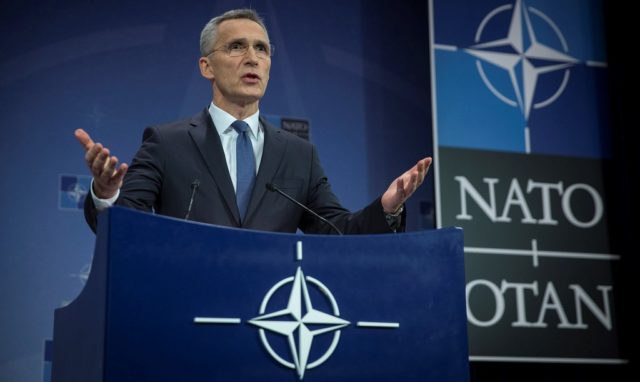Editor’s Note: NATO was established in 1949, with 12 members, to curtail possible Soviet aggression against Europe; it now has 28 members. After the collapse of communism and demise of the Soviet Union, many predicted the demise of the Atlantic Alliance. It survived as a high-level political agency for managing transatlantic relations and later as a regional crisis management agency, open to former members of the Warsaw Pact and taking on more global responsibilities. Another transformation may be coming.
As French philosopher and essayist Paul Valéry noted in 1937, “the trouble with our times is that the future is not what it used to be.” The sentiment applies to the North Atlantic Treaty Organization and a mission that’s been in a state of constant flux since the end of the Cold War.
NATO has transformed for at least five futures.
Five Futures
In the 1990’s, realists predicted NATO’s imminent demise, pointing out that no alliance in history had outlived the disappearance of the threat against which it was formed. But NATO survived the 1990’s as a high-level political agency for managing transatlantic relations. U.S. proposals that the alliance should “go out of area or out of business” reflected a sense in Washington that payback time had come for 40 years of unconditional U.S. security guarantees to Europe. Europeans in general balked at the idea of offering blanket support to U.S. global strategy. NATO’s first post–Cold War future ended in deadlock.
Conflicts in the Balkans (1991-1999) offered a brief second future for NATO as a regional crisis management agency, a profile encapsulated in the 1999 “new strategic concept” adopted at the 50th anniversary summit in Washington and best articulated, several days previously, by Tony Blair’s Chicago speech on the necessity of humanitarian intervention.
In Bosnia (1995) and in Kosovo (1999), NATO conducted its first military operations, seemingly demonstrating that it could go “out of area” and put an end to ethnic cleansing. These operations proved controversial. An international commission of inquiry deemed the Kosovo campaign as “illegal but legitimate.” Moscow subsequently used the campaign as a precedent for Russian unilateral interventions in Georgia and Ukraine/Crimea. NATO’s first “shots in anger” rebounded awkwardly.
Meanwhile, a third future for NATO was devised in the mid-1990’s with membership expanded to former members of the Warsaw Pact. This process, conducted in the name of a Europe “whole and free,” saw the alliance progressively advance to Russia’s borders. In 1997, George Kennan, the father of containment, denounced NATO expansion as “the most fateful error of American policy in the entire post-Cold War era.” As Kennan predicted, Moscow’s reaction, especially under Vladimir Putin, has been robustly reactive. In 2016, the eminent Russian and East European expert Richard Sakwa commented acerbically that “NATO exists to manage the risks created by its existence.”
The 9/11 attacks provided a fourth future for the alliance. For the first time, the day after the twin towers fell, NATO invoked “Article 5” – an attack on one member-state is an attack on all. The U.S. response was initially ambivalent. The Pentagon, still furious at European leaders for vetoing specific bombing runs during the Kosovo war in the 1990s, had no desire to involve NATO in Afghanistan. Key allies United Kingdom and France were cherry-picked to assist.
Going Global
But once the Bush administration switched its attention from Afghanistan to Iraq, the alliance as a whole was called into service and a fifth future was envisaged to stabilize the former while the U.S. military focused on the latter. NATO took over the UN-mandated International Security Assistance Force, (ISAF) in 2003. Almost by default, NATO had in effect “gone global,” thereby giving rise to the brief campaign from 2004 to 2008 to create a global alliance incorporating democracies including Japan, India, Australia and even Israel. During the 2008 election campaign, Republican candidate John McCain advocated NATO’s transmogrification into a “League of Democracies.” That idea, universally rejected by the European allies, fizzled along with McCain’s presidential bid. So, to all intents and purposes, did NATO’s brief experiment with “going global,” as the ISAF experience proved both politically divisive and a military failure. ISAF was disbanded in 2014, and NATO’s future seemed once again up for grabs.
Libya
Meanwhile, in 2011, the alliance engaged in a renewed experiment with humanitarian intervention and in mid-March launched “Operation Unified Protector” in Libya. This operation proved as controversial as the Kosovo mission and considerably more counterproductive. Exactly half of the NATO member states were politically opposed to the mission, with only a handful engaging in the airstrikes intended to protect the Libyan population from the predations of Muammar Qaddafi. In mid-April, the mission morphed from protection of the population to regime change, ensuring prolongation for six months until Qaddafi’s death in October. The spillover from this mission destabilized much of North Africa and the Sahel, galvanized radical Islamists from Nigeria to Syria, and precipitated Libya into a still ongoing civil war. Perhaps the most notable aspect of the Libyan operation was the explicit new posture of the United States – a key feature of what came to be known as the “Obama Doctrine” – American “leadership from behind.” European states were expected to take on the heavy lifting.
The notion at the heart of President Donald Trump’s initial assertion that “NATO is obsolete” is a variant on the Obama doctrine and one that goes back to the Cold War period: burden-sharing. The American complaint is that the Europeans are free-riding on American security guarantees and should be cajoled (Obama) or threatened (Trump) into stumping up more resources for their own defense.
This political standoff between Europe and the United States has been rendered more complex by Putin’s actions. By annexing Crimea and intervening militarily in Ukraine and by appearing to threaten a number of NATO and EU member-states, particularly the Baltics, Putin has both thrown down the gauntlet to NATO and offered yet another, possibly its sixth, post–Cold War “future,” returning to its original role as a security trip-wire in Europe.
A Sixth Future?
A complexity surrounding this sixth “future” for NATO is that the Europeans have been developing their own “autonomous” security project, the Common Security and Defense Policy. This was sparked in the 1990’s both by European aspirations to become a global actor and by American pressure for the EU to take over responsibility for the stabilization of its Eastern and Southern neighborhoods. That pressure, growing in intensity over the past two decades, has become strident under President Trump.
This is not just a political football. Many leading American international relations academics have, in recent years, argued a strong case for progressive U.S. disengagement from NATO, accompanied by concomitant European assumption of command responsibilities within the alliance. Libya showcased America’s “leading from behind.” In a context where the Unted States sees its primary security challenges in the Asia-Pacific region and in the Middle East and where Europe faces challenges essentially in its own neighborhood, NATO’s status has become a major geostrategic conundrum.
In June 2016, the European Union published a document outlining the European Global Strategy. The objective is for the EU to achieve “strategic autonomy,” while at the same time engaging in ever- closer cooperation with NATO. While the document says little about the implementation of these seemingly contradictory projects, the way ahead seems clear.
Europe does not need two rival security entities in its relatively limited geographic space. EU-NATO cooperation, in my view, should lead over the next decade to the Europeanization of NATO. Under this schema, Europe would achieve strategic autonomy through its progressive apprenticeship in leadership via NATO, and the United States could reduce its footprint in the alliance and concentrate on strategic challenges elsewhere.
General Dwight D. Eisenhower said at the time of NATO’s creation in 1949: “If NATO is still needed in ten years, it will have failed in its mission.” Perhaps in 2029, its 80th anniversary, NATO can declare “mission accomplished” when Europeans become entirely self-reliant in security terms. That was the initial intention of NATO’s founding fathers.
Jolyon Howorth, Ph.D., is a visiting professor of political science and International affairs at Yale University, and is Jean Monnet Professor of European Politics and Emeritus Professor of European Studies at the University of Bath. This article is reprinted from YaleGlobal and the MacMillan Center at Yale.






